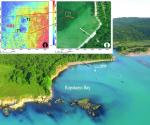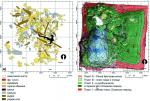Summary (English)
UNDERWATER ARCHAEOLOGICAL EXCAVATIONS IN FRONT OF THE MOUTH OF THE RIVER OF ROPOTAMO (Lyudmil Vagalinski – lvagalin@techno-link.com, Jonathan Adams, Kalin Dimitrov) In 1976, finds from Late Antiquity and the Middle Ages were occasionally discovered in front of the mouth of the River of Ropotamo during dredging works. In 1982 – 1989, underwater archaeological expeditions were carried out. In 1989, finds were discovered, interpreted as remains from a settlement of the Early Bronze Age, submerged during the sea level rise. In 2017, Trenches T1 and T2 were explored in Zone KV-2. In Stratum II from –3.60 m to –4.30 m in depth, sherds from Late Antiquity, the Middle Ages and the Ottoman period, pieces of wood, fragmentary mortar and stones with traces from fire were discovered. A Mediaeval anchor was found, too. In Stratum III from –4.50 m to –5.10 m in depth, sherds from the beginning of the Early Bronze Age were found. In Stratum IV from –5.10 m to –5.60 m in depth, a wooden post vertically driven into the ground and part of an oven or a hearth were discovered. A ceramic vessel of the beginning of the Early Bronze Age was also found. The strata of Late Antiquity, the Middle Ages and the Ottoman period indicated the existence of a harbor, at least from the Middle Ages onwards. The stratum of the beginning of the Early Bronze Age was related to a settlement situated on a terrace on the right bank of a small river that was a right tributary of the River of Ropotamo. Judging from the pottery, the settlement dated to the First Phase or the beginning of the Second Phase of the Early Bronze Age. The radiocarbon dating of the wooden post showed 4474±21 BP or 3335–3031 cal BC.
- Lyudmil Vagalinski - Archaeological Institute with Museum
- Jonathan Adams - Centre for Maritime Archaeology - University of Southampton
Director
- Kalin Dimitrov - Centre for Underwater Archaeology
Team
Research Body
- Archaeological Institute with Museum
- Centre for Maritime Archaeology - University of Southampton
- Centre for Underwater Archaeology






![Download [PDF]](/excavation/skins/fasti/images/results/download_sml.png)

